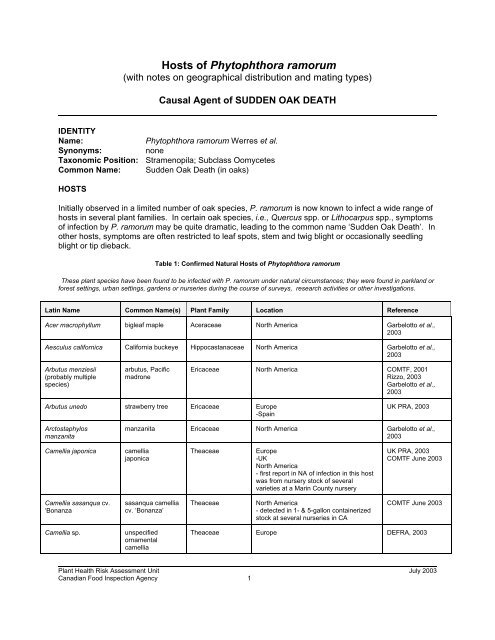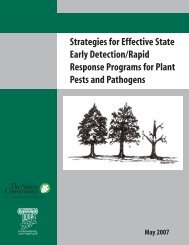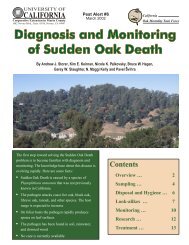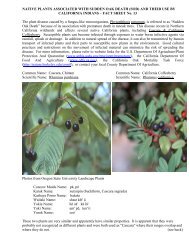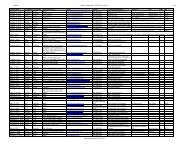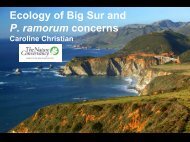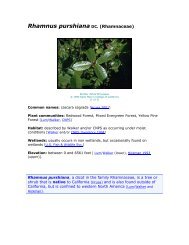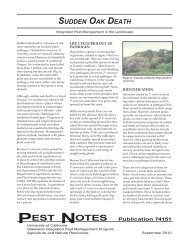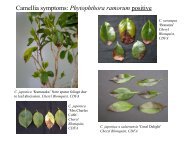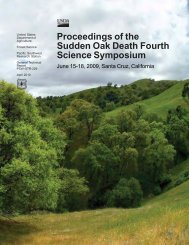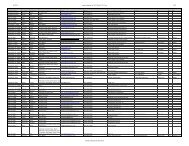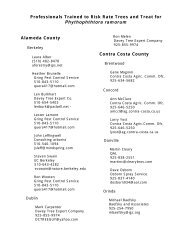Hosts of Phytophthora ramorum, CFIA, July, 2003 - Sudden Oak Death
Hosts of Phytophthora ramorum, CFIA, July, 2003 - Sudden Oak Death
Hosts of Phytophthora ramorum, CFIA, July, 2003 - Sudden Oak Death
You also want an ePaper? Increase the reach of your titles
YUMPU automatically turns print PDFs into web optimized ePapers that Google loves.
<strong>Hosts</strong> <strong>of</strong> <strong>Phytophthora</strong> <strong>ramorum</strong><br />
(with notes on geographical distribution and mating types)<br />
Causal Agent <strong>of</strong> SUDDEN OAK DEATH<br />
IDENTITY<br />
Name:<br />
<strong>Phytophthora</strong> <strong>ramorum</strong> Werres et al.<br />
Synonyms: none<br />
Taxonomic Position: Stramenopila; Subclass Oomycetes<br />
Common Name: <strong>Sudden</strong> <strong>Oak</strong> <strong>Death</strong> (in oaks)<br />
HOSTS<br />
Initially observed in a limited number <strong>of</strong> oak species, P. <strong>ramorum</strong> is now known to infect a wide range <strong>of</strong><br />
hosts in several plant families. In certain oak species, i.e., Quercus spp. or Lithocarpus spp., symptoms<br />
<strong>of</strong> infection by P. <strong>ramorum</strong> may be quite dramatic, leading to the common name ‘<strong>Sudden</strong> <strong>Oak</strong> <strong>Death</strong>’. In<br />
other hosts, symptoms are <strong>of</strong>ten restricted to leaf spots, stem and twig blight or occasionally seedling<br />
blight or tip dieback.<br />
Table 1: Confirmed Natural <strong>Hosts</strong> <strong>of</strong> <strong>Phytophthora</strong> <strong>ramorum</strong><br />
These plant species have been found to be infected with P. <strong>ramorum</strong> under natural circumstances; they were found in parkland or<br />
forest settings, urban settings, gardens or nurseries during the course <strong>of</strong> surveys, research activities or other investigations.<br />
Latin Name Common Name(s) Plant Family Location Reference<br />
Acer macrophyllum bigleaf maple Aceraceae North America Garbelotto et al.,<br />
<strong>2003</strong><br />
Aesculus californica California buckeye Hippocastanaceae North America Garbelotto et al.,<br />
<strong>2003</strong><br />
Arbutus menziesii<br />
(probably multiple<br />
species)<br />
arbutus, Pacific<br />
madrone<br />
Ericaceae North America COMTF, 2001<br />
Rizzo, <strong>2003</strong><br />
Garbelotto et al.,<br />
<strong>2003</strong><br />
Arbutus unedo strawberry tree Ericaceae Europe<br />
-Spain<br />
UK PRA, <strong>2003</strong><br />
Arctostaphylos<br />
manzanita<br />
manzanita Ericaceae North America Garbelotto et al.,<br />
<strong>2003</strong><br />
Camellia japonica<br />
camellia<br />
japonica<br />
Theaceae<br />
Europe<br />
-UK<br />
North America<br />
- first report in NA <strong>of</strong> infection in this host<br />
was from nursery stock <strong>of</strong> several<br />
varieties at a Marin County nursery<br />
UK PRA, <strong>2003</strong><br />
COMTF June <strong>2003</strong><br />
Camellia sasanqua cv.<br />
‘Bonanza<br />
sasanqua camellia<br />
cv. ‘Bonanza’<br />
Theaceae<br />
North America<br />
- detected in 1- & 5-gallon containerized<br />
stock at several nurseries in CA<br />
COMTF June <strong>2003</strong><br />
Camellia sp.<br />
unspecified<br />
ornamental<br />
camellia<br />
Theaceae Europe DEFRA, <strong>2003</strong><br />
Plant Health Risk Assessment Unit <strong>July</strong> <strong>2003</strong><br />
Canadian Food Inspection Agency 1
Latin Name Common Name(s) Plant Family Location Reference<br />
Corylus cornuta<br />
Heteromeles arbutifolia<br />
beaked filbert<br />
California hazelnut<br />
Christmas berry,<br />
toyon<br />
Betulaceae North America Murphy & Rizzo,<br />
2002<br />
Rosaceae North America Garbelotto et al.,<br />
<strong>2003</strong><br />
Kalmia latifolia mountain laurel Ericaceae Europe<br />
-UK<br />
UK PRA, <strong>2003</strong><br />
Leucothoe fontanesiana Europe - UNCONFIRMED REPORT UK PRA, <strong>2003</strong><br />
Lithocarpus densiflorus<br />
Lonicera hispidula<br />
tanoak, tanbark<br />
oak<br />
California<br />
honeysuckle, hairy<br />
honeysuckle, pink<br />
honeysuckle<br />
Fagaceae North America Storer et al., 2001<br />
Garbelotto et al.,<br />
2001<br />
Rizzo et al., 2002<br />
Garbelotto et al.,<br />
<strong>2003</strong><br />
Caprifoliaceae North America COMTF, November<br />
2001<br />
Pieris formosa var.<br />
forrestii<br />
Chinese pieris<br />
Himilayan pieris<br />
Ericaceae<br />
Europe<br />
-UK<br />
UK PRA, <strong>2003</strong><br />
Pieris japonica Japanese pieris Ericaceae Europe<br />
-UK<br />
North America<br />
-isolated from potted plant in vicinity <strong>of</strong><br />
heavily infected bay in CA<br />
- detected in containerized stock in an OR<br />
nursery - ‘Variegata’ and ‘Flaming Silver’<br />
UK PRA, <strong>2003</strong><br />
COMTF, March<br />
<strong>2003</strong><br />
ODA, <strong>2003</strong><br />
Pieris sp.<br />
unspecified<br />
evergreen shrub<br />
cultivated in<br />
Europe; genus is<br />
native to North<br />
America & Asia<br />
Ericaceae<br />
Europe<br />
North America<br />
- detected in containerized P. japonica X<br />
formosa hybrid stock in an OR nursery -<br />
‘Forest Flame’<br />
DEFRA, <strong>2003</strong><br />
ODA, <strong>2003</strong><br />
Pittosporum undulatum Victorian box Pittosporaceae North America<br />
- detected by PCR from CA material;<br />
lesions present but isolation unsuccessful<br />
Huberli, pers.<br />
comm.<br />
Pseudotsuga menziesii Douglas-fir Pinaceae North America Davidson et al.,<br />
2002<br />
Garbelotto et al.,<br />
<strong>2003</strong><br />
Quercus agrifolia coast live oak Fagaceae North America Storer et al., 2001<br />
Garbelotto et al.,<br />
2001<br />
Rizzo et al., 2002<br />
Garbelotto et al.,<br />
<strong>2003</strong><br />
Quercus chrysolepis canyon live oak Fagaceae North America Murphy & Rizzo,<br />
<strong>2003</strong><br />
Plant Health Risk Assessment Unit <strong>July</strong> <strong>2003</strong><br />
Canadian Food Inspection Agency 2
Latin Name Common Name(s) Plant Family Location Reference<br />
Quercus kelloggii black oak Fagaceae North America Storer et al., 2001<br />
Garbelotto et al.,<br />
2001<br />
Rizzo et al., 2002<br />
Garbelotto et al.,<br />
<strong>2003</strong><br />
Quercus parvula var.<br />
shrevei<br />
Shreve’s oak Fagaceae North America Storer et al., 2001<br />
Rizzo et al., 2002<br />
Rhamnus californica c<strong>of</strong>feeberry Rhamnaceae North America Garbelotto et al.,<br />
<strong>2003</strong><br />
Rhamnus purshiana cascara Rhamnaceae North America Goheen et al., 2002<br />
Rhododendron<br />
brachycarpum<br />
rhododendron Ericaceae Europe UK PRA, <strong>2003</strong><br />
Rhododendron<br />
catawbiense<br />
rhododendron<br />
hybrids<br />
‘Catawbiense<br />
Boursault’,<br />
‘Catawabiense<br />
Grandiflorum’,<br />
‘Everestianum’ &<br />
‘Roseum Elegans’<br />
Ericaceae<br />
Europe<br />
-Germany<br />
North America<br />
UK PRA, <strong>2003</strong><br />
Werres et al., 2001<br />
Rizzo, <strong>2003</strong><br />
Rhododendron<br />
caucasicum<br />
Rhododendron<br />
ferrugineum<br />
rhododendron Ericaceae Europe UK PRA, <strong>2003</strong><br />
rhododendron Ericaceae Europe UK PRA, <strong>2003</strong><br />
Rhododendron<br />
macrophyllum<br />
Pacific<br />
rhododendron<br />
Ericaceae North America Goheen et al., 2002<br />
Rizzo, <strong>2003</strong><br />
Rhododendron<br />
ponticum<br />
rhododendron Ericaceae Europe UK PRA, <strong>2003</strong><br />
Rhododendron repens rhododendron Ericaceae Europe UK PRA, <strong>2003</strong><br />
Rhododendron<br />
yakushimanum<br />
rhododendron Ericaceae Europe UK PRA, <strong>2003</strong><br />
De Merlier et al.,<br />
<strong>2003</strong><br />
Rhododendron spp<br />
rhododendron,<br />
azalea<br />
Ericaceae<br />
Europe<br />
North America<br />
Storer et al., 2001<br />
Werres et al., 2001<br />
Maralejo & Werres,<br />
2002<br />
Rhododendron sp.<br />
rhododendron<br />
‘Unique’<br />
Ericaceae<br />
North America<br />
- confirmed in containerized nursery stock<br />
in nurseries in OR & BC – ‘Unique’<br />
- A1 (European) mating type<br />
ODA, <strong>2003</strong><br />
<strong>CFIA</strong> News Release<br />
Rhus diversiloba poison oak Anacardiaceae North America Goheen et al., 2002<br />
Rubus spectabilis salmon berry Rosaceae North America Goheen et al., 2002<br />
Sequoia sempervirens coast redwood Taxodiaceae North America Maloney et al., 2002<br />
Garbelotto et al.,<br />
<strong>2003</strong><br />
Syringa sp. lilac Oleaceae Europe UK DEFRA, <strong>2003</strong><br />
Plant Health Risk Assessment Unit <strong>July</strong> <strong>2003</strong><br />
Canadian Food Inspection Agency 3
Latin Name Common Name(s) Plant Family Location Reference<br />
Toxicodendron<br />
diversilobum<br />
poison oak Anacardiaceae North America Rizzo, <strong>2003</strong><br />
Trientalis latifolia<br />
pacific or western<br />
starflower<br />
Primulaceae<br />
North America<br />
-confirmed in Monterey County, CA<br />
Hüberli et al., <strong>2003</strong><br />
Umbellularia californica<br />
Vaccinium ovatum<br />
California bay,<br />
California laurel,<br />
bay laurel, myrtle,<br />
pepperwood<br />
evergreen<br />
huckleberry<br />
Lauraceae North America Garbelotto et al.,<br />
<strong>2003</strong><br />
Ericaceae North America Storer et al., 2001<br />
Goheen et al., 2002<br />
Garbelotto et al.,<br />
<strong>2003</strong><br />
Vaccinium vitis-idaea lignonberry Ericaceae Europe<br />
-detected on imported material (source<br />
unknown) in Poland<br />
Orlikowski & Szkuta,<br />
2002<br />
Viburnum X<br />
bodnantense<br />
Hybrid between V.<br />
farreri & V.<br />
grandiflorum<br />
Caprifoliaceae<br />
Europe<br />
-basal cankers develop but leaf lesions<br />
are not observed in field situations<br />
suggesting the possibility that infection<br />
occurs through the roots in this host; leaf<br />
& stem inoculation assays were<br />
unsuccessful in initiating infection<br />
Werres et al., 2001<br />
Husson et al., <strong>2003</strong><br />
de Gruyter et al.,<br />
<strong>2003</strong><br />
De Merlier et al.,<br />
<strong>2003</strong><br />
North America<br />
- detected in containerized stock at an OR<br />
nursery - ‘Dawn’<br />
ODA, <strong>2003</strong><br />
Viburnum X burkwoodii Hybrid between V.<br />
carlesii & V. utile<br />
Caprifoliaceae Europe UK PRA, <strong>2003</strong><br />
Viburnum davidii Viburnum Caprifoliaceae Europe UK PRA, <strong>2003</strong><br />
Viburnum farreri Viburnum Caprifoliaceae Europe UK PRA, <strong>2003</strong><br />
Viburnum fragans Viburnum Caprifoliaceae Europe Rizzo, <strong>2003</strong><br />
Viburnum opulus Viburnum Caprifoliaceae Europe UK PRA, <strong>2003</strong><br />
Viburnum plicatum Viburnum Caprifoliaceae Europe UK PRA, <strong>2003</strong><br />
Viburnum plicatum<br />
tomentosum<br />
doublefile<br />
viburnum<br />
Caprifoliaceae<br />
North America<br />
- confirmed on containerized nurserystock<br />
in an OR nursery - ‘Mariesii’<br />
ODA, <strong>2003</strong><br />
Viburnum tinus Viburnum Caprifoliaceae Europe Lane et al., 2002;<br />
Husson et al., <strong>2003</strong><br />
Viburnum spp. Viburnum Caprifoliaceae Europe Werres et al., 2001<br />
Husson et al., <strong>2003</strong><br />
Viburnum sp.<br />
‘Schneewolke’<br />
Viburnum Caprifoliaceae Europe Werres et al., 2001<br />
Plant Health Risk Assessment Unit <strong>July</strong> <strong>2003</strong><br />
Canadian Food Inspection Agency 4
Table 2: Assays <strong>of</strong> Susceptibilty to P. <strong>ramorum</strong><br />
These plant species have been artificially inoculated with <strong>Phytophthora</strong> <strong>ramorum</strong> using various methods to<br />
assess their susceptibility to infection by the pathogen. As noted, some, but not all, have been shown to be<br />
variably susceptible to infection under the test conditions, i.e., the fungus can be introduced to each artificially<br />
and subsequently become established causing symptoms <strong>of</strong> infection to develop. Various experimental<br />
designs and inoculation methods, and different ways <strong>of</strong> measuring susceptibility have been used by different<br />
authors, so direct comparisons or absolute measures <strong>of</strong> susceptibility are difficult to make. In addition, mating<br />
type <strong>of</strong> the test isolates is not always reported, but origin(s) <strong>of</strong> the specimen(s) may give some indiction <strong>of</strong> the<br />
probable mating type. Some <strong>of</strong> these hosts are also natural hosts and are included in the above table, but<br />
others have not been found infecting hosts under natural conditions. Additional information is needed to<br />
determine the extent to which susceptible species could be affected by <strong>Phytophthora</strong> <strong>ramorum</strong> and the role<br />
they may play in the epidemiology <strong>of</strong> sudden oak death.<br />
Latin Name Common Name(s) Plant Family Comments Reference<br />
Acer spp. maple Aceraceae North American & European isolates<br />
tested; no significant differences; slightly<br />
susceptible spp. in genus<br />
Inman et al., 2002<br />
Acer campestre<br />
field or hedge<br />
maple<br />
Aceraceae<br />
mating type not specified, both American<br />
& European types used in study - results<br />
<strong>of</strong> leaf inoculation assays indicate<br />
resistance<br />
UK PRA, <strong>2003</strong><br />
Acer palmatum Japanese maple Aceraceae North American isolates, detached leaf<br />
assay results indicate high susceptibility<br />
Acer pseudoplatanus sycamore Aceraceae mating type not specified, both American<br />
& European types used in study - results<br />
<strong>of</strong> inner bark inoculations indicate “less”<br />
susceptibility<br />
Results <strong>of</strong> leaf inoculation assays indicate<br />
slight susceptibility<br />
Parke et al., 2002<br />
UK PRA, <strong>2003</strong><br />
Brasier et al., 2002<br />
UK PRA, <strong>2003</strong><br />
Aesculus<br />
hippocastanum<br />
horse chestnut Hippocastanaceae mating type not specified, both American<br />
& European types used in study - results<br />
<strong>of</strong> inner bark inoculations indicate “less”<br />
susceptibility<br />
UK PRA, <strong>2003</strong><br />
Brasier et al., 2002<br />
Alnus glutinosa<br />
European alder<br />
black alder<br />
Betulaceae<br />
mating type not specified, both American<br />
& European types used in study - results<br />
<strong>of</strong> inner bark inoculations indicate “less”<br />
susceptibility<br />
UK PRA, <strong>2003</strong><br />
Brasier et al., 2002<br />
results <strong>of</strong> leaf inoculation assay indicate<br />
potential to be resistant<br />
UK PRA, <strong>2003</strong><br />
Alnus spp. alder Betulaceae mating type not specified - results <strong>of</strong> leaf<br />
inoculation assays indicate potential<br />
resistance or immunity<br />
Arbutus unedo strawberry tree Ericaceae mating type & origin <strong>of</strong> isolate not stated,<br />
work conducted in Spain - detached leaf<br />
assay results indicate high susceptibility,<br />
conspicuous necrotic lesions were<br />
apparent 72 hours after inoculation,<br />
extensive blight developed in 9 days<br />
Inman et al., 2002<br />
Moralejo &<br />
Hernandez, 2002<br />
Arctostaphylos uvaursi<br />
bearberry Ericaceae Californian isolate 0-217 & type culture<br />
9/95 (European), detached leaf assays<br />
resulted in mean lesion area <strong>of</strong> 10.2%<br />
total leaf surface<br />
Tooley & Englander,<br />
2002<br />
Plant Health Risk Assessment Unit <strong>July</strong> <strong>2003</strong><br />
Canadian Food Inspection Agency 5
Latin Name Common Name(s) Plant Family Comments Reference<br />
Arctostaphylos uvaursi<br />
common bearberry Ericaceae North American & European isolates<br />
tested, no distinction in results reported -<br />
leaf inoculation studies indicate potential<br />
to be moderately susceptible<br />
UK PRA, <strong>2003</strong><br />
Arctostaphylos spp. bearberry Ericaceae North American & European isolates<br />
tested; no significant differences;<br />
potentially moderately susceptible spp. in<br />
genus<br />
Aucuba japonica Japanese laurel Aucubaceae North American & European isolates<br />
tested, no distinction in results reported -<br />
leaf inoculation studies indicate potential<br />
to be virtually immune<br />
Inman et al., 2002<br />
UK PRA, <strong>2003</strong><br />
Betula pubescens<br />
European birch<br />
downy birch<br />
Betulaceae<br />
mating type not specified, both American<br />
& European types used in study - results<br />
<strong>of</strong> inner bark inoculations indicate “less”<br />
susceptibility<br />
UK PRA, <strong>2003</strong><br />
Brasier et al., 2002<br />
Buddleia davidii<br />
butterfly bush,<br />
summer lilac<br />
Loganiaceae<br />
North American isolates, detached leaf<br />
assay results indicate high susceptibility<br />
Parke et al., 2002<br />
North American & European isolates<br />
tested, no distinction in results reported -<br />
leaf inoculation studies indicate potential<br />
to be virtually immune<br />
UK PRA, <strong>2003</strong><br />
Calluna sp. heath Ericaceae North American & European isolates<br />
tested, no distinction in results reported -<br />
leaf inoculation studies indicate potential<br />
to be virtually immune<br />
Camellia japonica common camellia Ericaceae North American & European isolates<br />
tested, no distinction in results reported -<br />
leaf inoculation studies indicate potential<br />
to be highly susceptible<br />
Camellia japonica common camellia Ericaceae mating type and origin <strong>of</strong> isolate(s) not<br />
stated, work conducted in North America -<br />
V. davidii essentially not susceptible in<br />
detached leaf assays<br />
Camellia camellia Ericaceae North American & European isolates<br />
tested; no significant differences;<br />
potentially highly susceptible spp. in<br />
genus<br />
Carpinus betula hornbeam Corylaceae mating type not specified, both American<br />
& European types used in study - results<br />
<strong>of</strong> inner bark inoculations indicate<br />
“resistant”<br />
Castanea sativa sweet chestnut Fagaceae mating type not specified, both American<br />
& European types used in study - results<br />
<strong>of</strong> inner bark inoculations indicate “less”<br />
susceptibility in some trials and “more”<br />
susceptibility in repeat trials with<br />
extensive bleeding observed on logs 3<br />
weeks after inoculation; bark may be<br />
more resistant than that <strong>of</strong> Quercus rubra<br />
UK PRA, <strong>2003</strong><br />
UK PRA, <strong>2003</strong><br />
Linderman et al.,<br />
2002<br />
Inman et al., 2002<br />
UK PRA, <strong>2003</strong><br />
Brasier et al., 2002<br />
UK PRA, <strong>2003</strong><br />
Brasier et al., 2002<br />
Brasier et al., <strong>2003</strong><br />
Plant Health Risk Assessment Unit <strong>July</strong> <strong>2003</strong><br />
Canadian Food Inspection Agency 6
Latin Name Common Name(s) Plant Family Comments Reference<br />
Castanopsis<br />
chryophylla<br />
giant chinquapin,<br />
giant chinkapin,<br />
golden chinkapin<br />
Fagaceae<br />
North American isolates - reaction as<br />
great as on tanoak in log inoculation<br />
studies<br />
Hansen & Sutton,<br />
2002<br />
Ceanothus impressus<br />
Californian lilac,<br />
Santa Barbara<br />
Rhamnaceae<br />
North American isolates, detached leaf<br />
assay results indicate high susceptibility<br />
Parke et al., 2002<br />
Ceratonia siliqua carob Leguminosae mating type & origin <strong>of</strong> isolate not stated,<br />
work conducted in Spain - detached leaf<br />
assay results indicate high susceptibility,<br />
conspicuous necrotic lesions were<br />
apparent 72 hours after inoculation,<br />
extensive blight developed in 9 days<br />
Moralejo &<br />
Hernandez, 2002<br />
Chaenomeles<br />
speciosa<br />
flowering quince Rosaceae North American (Oregon) isolates, mating<br />
type not stated - no symptoms were<br />
observed following detached leaf assays<br />
Parke et al., 2002<br />
Chamaecyparis<br />
lawsoniana<br />
Port-Orford cedar,<br />
Lawson’s cypress<br />
Pinaceae<br />
North American isolates - reaction as<br />
great as on tanoak in log inoculation<br />
studies<br />
Hansen & Sutton,<br />
2002<br />
Chamaecyparis<br />
lawsoniana<br />
Port-Orford cedar,<br />
Lawson’s cypress<br />
Pinaceae<br />
mating type not specified, both American<br />
& European types used in study - results<br />
<strong>of</strong> inner bark inoculations indicate “more”<br />
susceptibility<br />
UK PRA, <strong>2003</strong><br />
Brasier et al., 2002<br />
Chimaphila umbellata<br />
common prince’s<br />
pine<br />
ground holly<br />
wintergreen<br />
Pyrolaceae<br />
mating type & isolate origin not stated,<br />
probably OR isolate - detached leaf assay<br />
resulted in leaf necrosis indicating<br />
susceptibility<br />
Zanzot et al., 2002<br />
Choisya ternata<br />
Mexican orange<br />
blossom<br />
Rutaceae<br />
North American & European isolates<br />
tested, no distinction in results reported -<br />
leaf inoculation studies indicate potential<br />
to be virtually immune<br />
UK PRA, <strong>2003</strong><br />
Cistus salvifolius rock rose Cistaceae mating type & origin <strong>of</strong> isolate not stated,<br />
work conducted in Spain - results <strong>of</strong><br />
detached leaf assays indicate<br />
susceptibility to P. <strong>ramorum</strong><br />
Moralejo &<br />
Hernandez, 2002<br />
Clematis flammula<br />
fragrant virgin’s<br />
bower<br />
Ranunculaceae<br />
mating type & origin <strong>of</strong> isolate not stated,<br />
work conducted in Spain - results <strong>of</strong><br />
detached leaf assays indicate no<br />
susceptibility to P. <strong>ramorum</strong><br />
Moralejo &<br />
Hernandez, 2002<br />
Clematis montana anenome clematis Ranunculaceae North American isolates, detached leaf<br />
assay results indicate high susceptibility<br />
leaf inoculation studies, using both NA &<br />
EU isolates, indicate potential to be<br />
resistant<br />
Parke et al., 2002<br />
UK PRA, <strong>2003</strong><br />
Cornus alba<br />
tartarian<br />
white dogwood<br />
Cornaceae<br />
North American & European isolates<br />
tested, no distinction in results reported -<br />
leaf inoculation studies indicate potential<br />
to be resistant<br />
UK PRA, <strong>2003</strong><br />
Cornus florida flowering dogwood Cornaceae North American (Oregon) isolates, mating<br />
type not stated - no symptoms were<br />
observed following detached leaf assays<br />
Parke et al., 2002<br />
Plant Health Risk Assessment Unit <strong>July</strong> <strong>2003</strong><br />
Canadian Food Inspection Agency 7
Latin Name Common Name(s) Plant Family Comments Reference<br />
Corylus avellana<br />
filbert<br />
hazel<br />
Corylaceae<br />
North American & European isolates<br />
tested, no distinction in results reported -<br />
leaf inoculation studies indicate potential<br />
to be resistant<br />
UK PRA, <strong>2003</strong><br />
Corylus spp. hazel Corylaceae mating type not specified - results <strong>of</strong> leaf<br />
inoculation assays indicate potential<br />
resistance or immunity<br />
Inman et al., 2002<br />
Cotoneaster<br />
multiflorus<br />
cotoneaster Rosaceae North American (Oregon) isolates, mating<br />
type not stated - no symptoms were<br />
observed following detached leaf assays<br />
Parke et al., 2002<br />
Crataegus monogyna hawthorn Rosaceae North American & European isolates<br />
tested, no distinction in results reported -<br />
leaf inoculation studies indicate potential<br />
to be resistant<br />
Crataegus spp. hawthorn Rosaceae mating type not specified - results <strong>of</strong> leaf<br />
inoculation assays indicate potential<br />
resistance or immunity<br />
Erica cinerea heather Ericaceae North American & European isolates<br />
tested, no distinction in results reported -<br />
leaf inoculation studies indicate potential<br />
to be resistant<br />
UK PRA, <strong>2003</strong><br />
Inman et al., 2002<br />
UK PRA, <strong>2003</strong><br />
Eucalyptus<br />
eucalyptus<br />
gum<br />
Myrtaceae<br />
North American & European isolates<br />
tested; no significant differences;<br />
potentially highly susceptible spp. in<br />
genus<br />
Inman et al., 2002<br />
UK PRA, <strong>2003</strong><br />
Fagus sylvatica European beech Fagaceae mating type not specified, both American<br />
& European types used in study - results<br />
<strong>of</strong> inner bark inoculations indicate “more”<br />
susceptibility; in some tests, extensive<br />
bleeding was observed on inoculated logs<br />
after 3 weeks incubation; bark may be<br />
relatively more susceptible than that <strong>of</strong><br />
Quercus robur<br />
Fagus sylvatica European beech Fagaceae North American & European isolates<br />
tested, no distinction in results reported -<br />
susceptible; young plants inoculated<br />
through stem or leaf tissue exhibited<br />
severed twig dieback after 4 weeks<br />
Forsythia sp. golden bells Oleaceae North American & European isolates<br />
tested, no distinction in results reported -<br />
leaf inoculation studies indicate potential<br />
to be virtually immune<br />
Fraxinus excelsior European ash Oleaceae mating type not specified, both American<br />
& European types used in study - results<br />
<strong>of</strong> inner bark inoculations indicate<br />
“resistant”<br />
Fuchsia fuschia Onagraceae North American & European isolates<br />
tested; no significant differences;<br />
potentially moderately susceptible spp. in<br />
genus<br />
UK PRA, <strong>2003</strong><br />
Brasier et al., 2002<br />
Brasier et al., <strong>2003</strong><br />
de Gruyter et al.,<br />
2002<br />
UK PRA, <strong>2003</strong><br />
UK PRA, <strong>2003</strong><br />
Brasier et al., 2002<br />
Inman et al., 2002<br />
Plant Health Risk Assessment Unit <strong>July</strong> <strong>2003</strong><br />
Canadian Food Inspection Agency 8
Latin Name Common Name(s) Plant Family Comments Reference<br />
Gaultheria X<br />
wisleyensis<br />
gaultheria Ericaceae North American & European isolates<br />
tested, no distinction in results reported -<br />
leaf inoculation studies indicate potential<br />
to be slightly susceptible<br />
UK PRA, <strong>2003</strong><br />
Gaultheria shallon salal Ericaceae mating type and origin <strong>of</strong> isolate(s) not<br />
stated, work conducted in North America -<br />
V. davidii not susceptible in detached leaf<br />
assays<br />
Gaultheria wintergreen Ericaceae North American & European isolates<br />
tested; no significant differences; slightly<br />
susceptible spp. in genus<br />
Gleditsia triacanthos honeylocust Fabaceae North American isolates, detached leaf<br />
assay results indicate high susceptibility<br />
Hamamelis vernalis vernal witchhazel Styracaceae North American isolates, detached leaf<br />
assay results indicate high susceptibility<br />
Hedera helix English ivy Araliaceae mating type and origin <strong>of</strong> isolate(s) not<br />
stated, work conducted in North America -<br />
V. davidii not susceptible in detached leaf<br />
assays<br />
Humulus lupulus golden hop Cannabinaceae North American & European isolates<br />
tested, no distinction in results reported -<br />
leaf inoculation studies indicate potential<br />
to be virtually immune<br />
Hypericum ‘Hidcote’ St. John’s-wort Hypericaceae North American (Oregon) isolates, mating<br />
type not stated - no symptoms were<br />
observed following detached leaf assays<br />
Ilex aquifolium holly Aquifoliaceae North American & European isolates<br />
tested, no distinction in results reported -<br />
leaf inoculation studies indicate potential<br />
to be resistant<br />
Ilex aquifolium holly Aquifoliaceae mating type and origin <strong>of</strong> isolate(s) not<br />
stated, work conducted in North America -<br />
V. davidii essentially not susceptible in<br />
detached leaf assays<br />
Ilex spp. holly Aquifoliaceae mating type not specified - results <strong>of</strong> leaf<br />
inoculation assays indicate potential<br />
resistance or immunity<br />
Linderman et al.,<br />
2002<br />
Inman et al., 2002<br />
Parke et al., 2002<br />
Parke et al., 2002<br />
Linderman et al.,<br />
2002<br />
UK PRA, <strong>2003</strong><br />
Parke et al., 2002<br />
UK PRA, <strong>2003</strong><br />
Linderman et al.,<br />
2002<br />
Inman et al., 2002<br />
Kalmia latifolia<br />
mountain laurel<br />
‘Madeline’<br />
Ericaceae<br />
Californian isolate 0-217 & type culture<br />
9/95 (European) - detached leaf assays<br />
resulted in mean lesion area <strong>of</strong> 31.8%<br />
total leaf surface<br />
Tooley & Englander,<br />
2002<br />
Kalmia latifolia mountain laurel Ericaceae mating type and origin <strong>of</strong> isolate unknown<br />
- inoculation with isolates intercepted from<br />
rhododendron (origin unknown) indicate<br />
susceptibility<br />
Laurus nobilis English bay laurel Lauraceae North American & European isolates<br />
tested, no distinction in results reported -<br />
leaf inoculation studies indicate potential<br />
to be virtually immune<br />
Orlikowski & Szkuta,<br />
2002<br />
UK PRA, <strong>2003</strong><br />
Plant Health Risk Assessment Unit <strong>July</strong> <strong>2003</strong><br />
Canadian Food Inspection Agency 9
Latin Name Common Name(s) Plant Family Comments Reference<br />
Lavatera sp. tree mallow Malvaceae North American & European isolates<br />
tested, no distinction in results reported -<br />
leaf inoculation studies indicate potential<br />
to be virtually immune<br />
Leucothoe fetterbush Ericaceae North American & European isolates<br />
tested; no significant differences;<br />
potentially highly susceptible spp. in<br />
genus<br />
Ligustrum sp. hedge privet Oleaceae North American & European isolates<br />
tested, no distinction in results reported -<br />
leaf inoculation studies indicate potential<br />
to be resistant<br />
Linnaea borealis twinflower Caprifoliaceae mating type & isolate origin not stated,<br />
probably OR isolate - detached leaf assay<br />
resulted in leaf necrosis indicating<br />
susceptibility<br />
Lonicera implexa honeysuckle Caprifoliaceae mating type & origin <strong>of</strong> isolate not stated,<br />
work conducted in Spain - detached leaf<br />
assay results indicate high susceptibility,<br />
conspicuous necrotic lesions were<br />
apparent 72 hours after inoculation,<br />
extensive blight developed in 9 days<br />
UK PRA, <strong>2003</strong><br />
Inman et al., 2002<br />
UK PRA, <strong>2003</strong><br />
Zanzot et al., 2002<br />
Moralejo &<br />
Hernandez, 2002<br />
Lonicera<br />
periclymenum<br />
honeysuckle Caprifoliaceae North American & European isolates<br />
tested, no distinction in results reported -<br />
leaf inoculation studies indicate potential<br />
to be resistant<br />
young plants inoculated through stem or<br />
leaf with NA or EU isolates were<br />
unaffected after 4 weeks<br />
UK PRA, <strong>2003</strong><br />
deGruyter et al., 2002<br />
Malus sylvestris crab apple Rosaceae North American & European isolates<br />
tested, no distinction in results reported -<br />
leaf inoculation studies indicate potential<br />
to be slightly susceptible<br />
Malus Apple Rosaceae North American & European isolates<br />
tested; no significant differences; slightly<br />
susceptible spp. in genus<br />
Morus sp. mulberry Moraceae North American & European isolates<br />
tested, no distinction in results reported -<br />
leaf inoculation studies indicate potential<br />
to be virtually immune<br />
Olea europea Olive Oleaceae mating type & origin <strong>of</strong> isolate not stated,<br />
work conducted in Spain - detached leaf<br />
assay results indicate high susceptibility,<br />
conspicuous necrotic lesions were<br />
apparent 72 hours after inoculation,<br />
extensive blight developed in 9 days<br />
Oxydendrum arboreum Sourwood Ericaceae North American isolates, detached leaf<br />
assay results indicate high susceptibility<br />
UK PRA, <strong>2003</strong><br />
Inman et al., 2002<br />
UK PRA, <strong>2003</strong><br />
Moralejo &<br />
Hernandez, 2002<br />
Parke et al., 2002<br />
Pachysandra<br />
terminalis<br />
Japanese<br />
pachysandra<br />
Buxaceae<br />
mating type and origin <strong>of</strong> isolate(s) not<br />
stated, work conducted in North America -<br />
V. davidii essentially not susceptible in<br />
detached leaf assays<br />
Linderman et al.,<br />
2002<br />
Plant Health Risk Assessment Unit <strong>July</strong> <strong>2003</strong><br />
Canadian Food Inspection Agency 10
Latin Name Common Name(s) Plant Family Comments Reference<br />
Philadelphus<br />
coronarius<br />
mockorange Saxifragaceae North American (Oregon) isolates, mating<br />
type not stated - no symptoms were<br />
observed following detached leaf assays<br />
Parke et al., 2002<br />
Photinia serrulata Chinese photinia Rosaceae North American (Oregon) isolates, mating<br />
type not stated - no symptoms were<br />
observed following detached leaf assays<br />
Photinia Christmas berry Rosaceae North American & European isolates<br />
tested; no significant differences;<br />
potentially moderately susceptible spp. in<br />
genus<br />
Picea sitchensis Sitka spruce Pinaceae mating type not specified, both American<br />
& European types used in study - results<br />
<strong>of</strong> inner bark inoculations indicate “more”<br />
susceptibility<br />
Pieris floribunda fetterbush Ericaceae Californian isolate 0-217 & type culture<br />
9/95 (European), detached leaf assays<br />
resulted in mean lesion area <strong>of</strong> 27.8%<br />
total leaf surface<br />
Parke et al., 2002<br />
Inman et al., 2002<br />
UK PRA, <strong>2003</strong><br />
Brasier et al., 2002<br />
Tooley & Englander,<br />
2002<br />
Pieris japonica<br />
lily-<strong>of</strong>-the-valley<br />
bush<br />
Ericaceae<br />
North American & European isolates<br />
tested, no distinction in results reported -<br />
leaf inoculation studies indicate potential<br />
to be highly susceptible<br />
UK PRA, <strong>2003</strong><br />
Pieris japonica<br />
lily-<strong>of</strong>-the-valley<br />
bush<br />
Ericaceae<br />
mating type and origin <strong>of</strong> isolate unknown<br />
- inoculation with isolates intercepted from<br />
rhododendron (origin unknown) indicate<br />
susceptibility<br />
Orlikowski & Szkuta,<br />
2002<br />
Pieris spp. pieris Ericaceae North American & European isolates<br />
tested; no significant differences;<br />
potentially highly susceptible spp. in<br />
genus<br />
Inman et al., 2002<br />
Pistacia lentiscus<br />
evergreen pistache<br />
mastic tree<br />
Anacardiaceae<br />
mating type & origin <strong>of</strong> isolate not stated,<br />
work conducted in Spain - detached leaf<br />
assay results indicate high susceptibility,<br />
conspicuous necrotic lesions were<br />
apparent 72 hours after inoculation,<br />
extensive blight developed in 9 days<br />
Moralejo &<br />
Hernandez, 2002<br />
Populus sp. poplar Salicaceae mating type not specified, both American<br />
& European types used in study - results<br />
<strong>of</strong> inner bark inoculations indicate<br />
“resistant”<br />
UK PRA, <strong>2003</strong><br />
Brasier et al., 2002<br />
Prunus laurocerasus<br />
cherry laurel<br />
English laurel<br />
Rosaceae<br />
mating type not specified, both American<br />
& European types used in study - results<br />
<strong>of</strong> inner bark inoculations indicate “less”<br />
susceptibility<br />
UK PRA, <strong>2003</strong><br />
Brasier et al., 2002<br />
leaf inoculation assay results indicate<br />
slight susceptibility<br />
UK PRA, <strong>2003</strong><br />
Prunus lusitanica Portugal laurel Rosaceae North American & European isolates<br />
tested, no distinction in results reported -<br />
leaf inoculation studies indicate potential<br />
to be slightly susceptible<br />
UK PRA, <strong>2003</strong><br />
Plant Health Risk Assessment Unit <strong>July</strong> <strong>2003</strong><br />
Canadian Food Inspection Agency 11
Latin Name Common Name(s) Plant Family Comments Reference<br />
Prunus persicae nectarine Rosaceae North American & European isolates<br />
tested, no distinction in results reported -<br />
leaf inoculation studies indicate potential<br />
to be slightly susceptible<br />
Prunus spp. stonefruits Rosaceae North American & European isolates<br />
tested; no significant differences; slightly<br />
susceptible spp. in genus<br />
Pseudotsuga menzeisii Douglas-fir Pinaceae mating type not specified, both American<br />
& European types used in study - results<br />
<strong>of</strong> inner bark inoculations indicate “more”<br />
susceptibility<br />
Quercus cerris Turkey oak Fagaceae mating type not specified, both American<br />
& European types used in study - results<br />
<strong>of</strong> inner bark inoculations indicate “more<br />
susceptible” to 2 EU isolates and “less<br />
susceptible” to 2 NA isolates<br />
UK PRA, <strong>2003</strong><br />
Inman et al., 2002<br />
UK PRA, <strong>2003</strong><br />
Brasier et al., 2002<br />
Brasier et al., 2002<br />
Quercus chrysolepis<br />
California black<br />
oak<br />
Fagaceae<br />
North American isolates - reaction much<br />
less than on tanoak in log inoculation<br />
studies, small lesions developed following<br />
inoculation<br />
Hansen & Sutton,<br />
2002<br />
Quercus douglasii Blue oak Fagaceae North American isolates - no canker<br />
development was observed four months<br />
after inoculating seedlings, although the<br />
fungus remained viable & could be reisolated.<br />
Rizzo, unpublished<br />
Quercus garryana<br />
Oregon white oak,<br />
Garry oak<br />
Fagaceae<br />
North American isolates - reaction much<br />
less than on tanoak in log inoculation<br />
studies, small lesions developed following<br />
inoculation<br />
Hansen & Sutton,<br />
2002<br />
Quercus ilex holm oak Fagaceae A1 & A2 - amongst the most susceptible<br />
European forest spp.<br />
Quercus ilex holm oak Fagaceae mating type & origin <strong>of</strong> test isolates not<br />
stated, work conducted in Spain - results<br />
<strong>of</strong> detached leaf assays indicate<br />
susceptibility, limited lesion development<br />
after 9 days but the organism could be reisolated<br />
Brasier et al., 2002<br />
Moralejo &<br />
Hernandez, 2002<br />
Quercus kelloggii<br />
California black<br />
oak<br />
Fagaceae<br />
North American isolates - reaction much<br />
less than on tanoak in log inoculation<br />
studies, small lesions developed following<br />
inoculation<br />
Hansen & Sutton,<br />
2002<br />
Quercus lobata<br />
valley oak<br />
California white<br />
oak<br />
Fagaceae<br />
North American isolates - no canker<br />
development was observed four months<br />
after inoculating seedlings, although the<br />
fungus remained viable & could be reisolated.<br />
Rizzo, unpublished<br />
Quercus palustris northern pin oak Fagaceae Californian isolates, mating type not<br />
stated<br />
Rizzo 1 , unpublished<br />
1<br />
David Rizzo, Department <strong>of</strong> Plant Pathology, University <strong>of</strong> California, Davis, CA. Data presented at 2001<br />
Western International Forest Disease Work Conference, 10 - 14 September 2001, Carmel, California.<br />
Plant Health Risk Assessment Unit <strong>July</strong> <strong>2003</strong><br />
Canadian Food Inspection Agency 12
Latin Name Common Name(s) Plant Family Comments Reference<br />
Quercus robur<br />
English oak<br />
pedunculate oak<br />
Fagaceae French isolate, mating type not stated -<br />
moderate susceptibility, all plants<br />
produced bark necrosis with occasional<br />
bleeding but necrosis on inoculated<br />
leaves was rare; less susceptible than Q.<br />
agrifolia & L. densiflorus<br />
Delatour et al., 2002<br />
Quercus robur<br />
English oak<br />
pedunculate oak<br />
Fagaceae<br />
mating type not specified, both American<br />
& European types used in study - results<br />
<strong>of</strong> inner bark inoculations indicate “less”<br />
susceptibility; preliminary results indicate<br />
that bark is more resistant to infection<br />
than is the bark <strong>of</strong> Quercus rubra<br />
UK PRA, <strong>2003</strong><br />
Brasier et al., 2002<br />
Brasier et al., <strong>2003</strong><br />
Quercus robur<br />
English oak<br />
pedunculate oak<br />
Fagaceae<br />
North American & European isolates<br />
tested, no distinction in results reported -<br />
young plants inoculated through stem or<br />
leaf tissue showed no symptoms after 4<br />
weeks, resistant<br />
de Gruyter et al.,<br />
2002<br />
Quercus rubra red oak Fagaceae Californian isolates, mating type not<br />
stated<br />
Quercus rubra red oak Fagaceae mating type not specified, both American<br />
& European types used in study - results<br />
<strong>of</strong> inner bark inoculations indicate “more”<br />
susceptibility<br />
Quercus rubra red oak Fagaceae North American & European isolates<br />
tested, no distinction in results reported -<br />
susceptible; young plants inoculated<br />
through stem or leaf tissue exhibited<br />
severed twig dieback after 4 weeks<br />
Quercus suber cork oak Fagaceae mating type not specified, both American<br />
& European types used in study - results<br />
<strong>of</strong> inner bark inoculations indicate “less”<br />
susceptibility<br />
Rizzo 1 , unpublished<br />
UK PRA, <strong>2003</strong><br />
Brasier et al., 2002<br />
de Gruyter et al.,<br />
2002<br />
UK PRA, <strong>2003</strong><br />
Brasier et al., 2002<br />
Rhamnus alaternus<br />
Italian buckthorn<br />
evergreen<br />
buckthorn<br />
Rhamnaceae<br />
mating type & origin <strong>of</strong> isolate not stated,<br />
work conducted in Spain - detached leaf<br />
assay results indicate high susceptibility,<br />
conspicuous necrotic lesions were<br />
apparent 72 hours after inoculation,<br />
extensive blight developed in 9 days<br />
Moralejo &<br />
Hernandez, 2002<br />
Rhaphiolepis<br />
umbellata<br />
round-leaf<br />
hawthorn<br />
Rosaceae<br />
North American (Oregon) isolates, mating<br />
type not stated - no symptoms were<br />
observed following detached leaf assays<br />
Parke et al., 2002<br />
Rhododendron<br />
japonicum<br />
Rhododendron<br />
maximum<br />
Rhododendron<br />
occidentale<br />
azalea Ericaceae North American & European isolates<br />
tested, no distinction in results reported -<br />
leaf inoculation studies indicate potential<br />
to be resistant<br />
rhododendron Ericaceae Californian isolate 0-217 & type culture<br />
9/95 (European), detached leaf assays<br />
resulted in mean lesion area <strong>of</strong> 5.9% total<br />
leaf surface<br />
western azalea Ericaceae mating type not specified, Californian<br />
isolate probable - highly susceptible in<br />
detached leaf assay<br />
UK PRA, <strong>2003</strong><br />
Tooley & Englander,<br />
2002<br />
Tjosvold et al., 2002<br />
Plant Health Risk Assessment Unit <strong>July</strong> <strong>2003</strong><br />
Canadian Food Inspection Agency 13
Latin Name Common Name(s) Plant Family Comments Reference<br />
Rhododendron<br />
ponticum<br />
rhododendron Ericaceae mating type not specified, both American<br />
& European types used in study - results<br />
<strong>of</strong> inner bark inoculations indicate “more”<br />
susceptibility<br />
1-2 year old seedlings developed severe<br />
leaf & stem lesions following inoculation<br />
with either EU or NA isolates; very<br />
susceptible<br />
UK PRA, <strong>2003</strong><br />
Brasier et al., 2002<br />
de Gruyter et al.,<br />
2002<br />
Rhododendron simsii Sim’s azalea Ericaceae North American & European isolates<br />
tested, no distinction in results reported -<br />
leaf inoculation studies indicate potential<br />
to be resistant<br />
UK PRA, <strong>2003</strong><br />
Rhododendron<br />
‘Girard’s rose’<br />
azalea<br />
Ericaceae<br />
Californian isolate 0-217 & type culture<br />
9/95 (European), detached leaf assays<br />
resulted in mean lesion area <strong>of</strong> 15.9%<br />
total leaf surface<br />
Tooley & Englander,<br />
2002<br />
Rhododendron<br />
azalea<br />
‘Northern Hilites’<br />
Ericaceae<br />
mating type not specified, Californian<br />
isolate probable - highly susceptible in<br />
detached leaf assay<br />
Tjosvold et al., 2002<br />
Rhododendron<br />
rhododendron<br />
‘Cunningham’s<br />
white’<br />
Ericaceae<br />
mating type not specified, Californian<br />
isolate probable - highly susceptible in<br />
detached leaf assay<br />
Tjosvold et al., 2002<br />
Rhododendron<br />
rhododendron<br />
‘Cunningham’s<br />
white’<br />
Ericaceae<br />
Californian isolate 0-217 & type culture<br />
9/95 (European), detached leaf assays<br />
resulted in mean lesion area <strong>of</strong> 17.4%<br />
total leaf surface<br />
Tooley & Englander,<br />
2002<br />
Rhododendron<br />
florist’s azalea<br />
’Inga’<br />
Ericaceae<br />
Californian isolate 0-217 & type culture<br />
9/95 (European), detached leaf assays<br />
resulted in mean lesion area <strong>of</strong> 4.4% total<br />
leaf surface<br />
Tooley & Englander,<br />
2002<br />
Rhododendron<br />
rhododendron<br />
‘Exbury’ hybrids<br />
Ericaceae<br />
North American isolates, detached leaf<br />
assay results indicate high susceptibility<br />
Parke et al., 2002<br />
Rhododendron azaleas Ericaceae North American & European isolates<br />
tested; no significant differences; slightly<br />
susceptible spp. in genus<br />
Deciduous azaleas were generally more<br />
susceptible in detached leaf assay<br />
studies than were evergreen azaleas<br />
similarly challenged.<br />
Inman et al., 2002<br />
Tjosvold et al., 2002<br />
UK PRA, <strong>2003</strong><br />
detached leaf assays with both NA & EU<br />
isolates indicate potential to be virtually<br />
immune<br />
Ribes sanguineum<br />
flowering currant,<br />
winter currant<br />
Grossulariaceae<br />
North American isolates, detached leaf<br />
assay results indicate high susceptibility<br />
Parke et al., 2002<br />
Rosa sempervirens evergreen rose Rosaceae mating type & origin <strong>of</strong> isolates not stated,<br />
work conducted in Spain - detached leaf<br />
assay results indicate susceptibility, no<br />
further details<br />
Moralejo &<br />
Hernandez, 2002<br />
Plant Health Risk Assessment Unit <strong>July</strong> <strong>2003</strong><br />
Canadian Food Inspection Agency 14
Latin Name Common Name(s) Plant Family Comments Reference<br />
Rubus fruticosus bramble Rosaceae North American & European isolates<br />
tested, no distinction in results reported -<br />
leaf inoculation studies indicate potential<br />
to be virtually immune<br />
Rubus ulmifolius blackberry Rosaceae mating type & origin <strong>of</strong> isolates not stated,<br />
work conducted in Spain - results <strong>of</strong><br />
detached leaf assays indicate no<br />
susceptibility to P. <strong>ramorum</strong><br />
Sambucus racemosa red-berried elder Caprifoliaceae North American & European isolates<br />
tested, no distinction in results reported -<br />
leaf inoculation studies indicate potential<br />
to be highly susceptible<br />
Sambucus nigra common elder Caprifoliaceae North American & European isolates<br />
tested, no distinction in results reported -<br />
leaf inoculation studies indicate potential<br />
to be highly susceptible<br />
Sambucus spp. elderberry Caprifoliaceae North American & European isolates<br />
tested; no significant differences;<br />
potentially highly susceptible spp. in<br />
genus<br />
Sequoia sempervirens coast redwood Taxodiaceae mating type not specified, both American<br />
& European types used in study - results<br />
<strong>of</strong> inner bark inoculations indicate “less”<br />
susceptibility<br />
Skimmia japonica Japanese skimmia Rutaceae North American & European isolates<br />
tested, no distinction in results reported -<br />
leaf inoculation studies indicate potential<br />
to be virtually immune<br />
Smilax aspersa greenbrier Liliaceae mating type & origin <strong>of</strong> isolates not stated,<br />
work conducted in Spain - detached leaf<br />
assay results indicate susceptibility, no<br />
further details<br />
Spiraea japonica Japanese spirea Rosaceae North American & European isolates<br />
tested, no distinction in results reported -<br />
leaf inoculation studies indicate potential<br />
to be virtually immune<br />
Symphoricarpus albus snowberry Caprifoliaceae North American & European isolates<br />
tested, no distinction in results reported -<br />
leaf inoculation studies indicate potential<br />
to be moderately susceptible<br />
Symphoricarpus snowberry Caprifoliaceae North American & European isolates<br />
tested; no significant differences;<br />
potentially moderately susceptible spp. in<br />
genus<br />
Syringa lilac Myrtaceae North American & European isolates<br />
tested; no significant differences;<br />
potentially highly susceptible spp. in<br />
genus<br />
Taxus baccata yew Taxaceae mating type not specified, both American<br />
& European types used in study - results<br />
<strong>of</strong> inner bark inoculations indicate “less”<br />
susceptibility<br />
UK PRA, <strong>2003</strong><br />
Inman et al., 2002<br />
Moralejo &<br />
Hernandez, 2002<br />
UK PRA, <strong>2003</strong><br />
UK PRA, <strong>2003</strong><br />
Inman et al., 2002<br />
UK PRA, <strong>2003</strong><br />
Brasier et al., 2002<br />
UK PRA, <strong>2003</strong><br />
Moralejo &<br />
Hernandez, 2002<br />
UK PRA, <strong>2003</strong><br />
UK PRA, <strong>2003</strong><br />
Inman et al., 2002<br />
Inman et al., 2002<br />
UK PRA, <strong>2003</strong><br />
UK PRA, <strong>2003</strong><br />
Brasier et al., 2002<br />
Plant Health Risk Assessment Unit <strong>July</strong> <strong>2003</strong><br />
Canadian Food Inspection Agency 15
Latin Name Common Name(s) Plant Family Comments Reference<br />
Tilia cordata small-leafed lime Tiliaceae mating type not specified, both American<br />
& European types used in study - results<br />
<strong>of</strong> inner bark inoculations indicate<br />
“resistant”<br />
Ulmus glabra Wych elm Ulmaceae North American & European isolates<br />
tested, no distinction in results reported -<br />
leaf inoculation studies indicate potential<br />
to be moderately susceptible<br />
Ulmus procera English elm Ulmaceae mating type not specified, both American<br />
& European types used in study - results<br />
<strong>of</strong> inner bark inoculations indicate<br />
“resistant”<br />
UK PRA, <strong>2003</strong><br />
Brasier et al., 2002<br />
UK PRA, <strong>2003</strong><br />
UK PRA, <strong>2003</strong><br />
Brasier et al., 2002<br />
Ulmus<br />
ornamental yellowleafed<br />
Scots elm<br />
Ulmaceae<br />
North American & European isolates<br />
tested, no distinction in results reported -<br />
leaf inoculation studies indicate potential<br />
to be moderately susceptible<br />
UK PRA, <strong>2003</strong><br />
Ulmus elm Ulmaceae North American & European isolates<br />
tested; no significant differences;<br />
potentially moderately susceptible spp. in<br />
genus<br />
Inman et al., 2002<br />
Vaccinium<br />
corymbosum<br />
blueberry Ericaceae North American & European isolates<br />
tested, no distinction in results reported -<br />
leaf inoculation studies indicate potential<br />
to be resistant<br />
UK PRA, <strong>2003</strong><br />
Vaccinium myrtillus<br />
European wild<br />
blueberry<br />
Ericaceae<br />
North American & European isolates<br />
tested, no distinction in results reported -<br />
susceptible; young plants inoculated<br />
through stem or leaf tissue died within 4<br />
weeks<br />
de Gruyter et al.,<br />
2002<br />
Vaccinium parviflorum red huckleberry Ericaceae mating type & isolate origin not stated,<br />
probably OR isolate - detached leaf assay<br />
resulted in leaf necrosis indicating<br />
susceptibility<br />
Zanzot et al., 2002<br />
Vaccinium spp.,<br />
including V.<br />
corymbosum and V.<br />
corymbosum X V.<br />
angustifolium<br />
commercial<br />
blueberry<br />
Ericaceae<br />
North American isolates, mating type not<br />
stated - results <strong>of</strong> detached leaf assays<br />
indicate a range <strong>of</strong> susceptibility amongst<br />
commercial & wild species <strong>of</strong> Vaccinium<br />
from resistant (cranberry) to highly<br />
susceptible (lignonberry)<br />
Parke et al., 2002b<br />
Vaccinium vitis-idaea lignonberry Ericaceae (heath<br />
family)<br />
North American isolates, mating type not<br />
stated - results <strong>of</strong> detached leaf assays<br />
indicate susceptibility<br />
(Note that this species has been found to<br />
be naturally infected in Europe, see Table<br />
1)<br />
Parke et al., 2002<br />
Viburnum X<br />
bodnantense<br />
viburnum Ericaceae North American & European isolates<br />
tested, no distinction in results reported -<br />
young plants inoculated through stem or<br />
leaf tissue were free <strong>of</strong> apparent damage<br />
de Gruyter et al.,<br />
2002<br />
Viburnum davidii viburnum Ericaceae North American & European isolates<br />
tested, no distinction in results reported -<br />
leaf inoculation studies indicate potential<br />
to be slightly susceptible<br />
UK PRA, <strong>2003</strong><br />
Plant Health Risk Assessment Unit <strong>July</strong> <strong>2003</strong><br />
Canadian Food Inspection Agency 16
Latin Name Common Name(s) Plant Family Comments Reference<br />
Viburnum davidii viburnum Ericaceae mating type and origin <strong>of</strong> isolate(s) not<br />
stated, work conducted in North America -<br />
V. davidii susceptible in detached leaf<br />
assays to P. <strong>ramorum</strong>, but not to other<br />
Phythothora spp.<br />
Viburnum opulus guelder rose Ericaceae North American & European isolates<br />
tested, no distinction in results reported -<br />
leaf inoculation studies indicate potential<br />
to be resistant<br />
Linderman et al.,<br />
2002<br />
UK PRA, <strong>2003</strong><br />
Inman et al., 2002<br />
Viburnum plicatum var.<br />
tomonentosum<br />
viburnum Ericaceae mating type and origin <strong>of</strong> isolate(s) not<br />
stated, work conducted in North America -<br />
V. davidii susceptible in detached leaf<br />
assays to P. <strong>ramorum</strong>, but not to other<br />
Phythothora spp.<br />
Linderman et al.,<br />
2002<br />
Viburnum tinus<br />
viburnum<br />
laurustinus<br />
Caprifoliaceae<br />
North American isolates, detached leaf<br />
assay results indicate high susceptibility<br />
Parke et al., 2002<br />
Viburnum tinus<br />
viburnum<br />
laurustinus<br />
Caprifoliaceae<br />
North American & European isolates<br />
tested, no distinction in results reported -<br />
leaf inoculation studies indicate potential<br />
to be moderately susceptible<br />
UK PRA, <strong>2003</strong><br />
Viburnum viburnum Caprifoliaeceae North American & European isolates<br />
tested; no significant differences;<br />
potentially moderately susceptible spp. in<br />
genus<br />
Vitis vinifera grapevine Vitaceae North American & European isolates<br />
tested, no distinction in results reported -<br />
leaf inoculation studies indicate potential<br />
to be virtually immune<br />
Weigela japonica Japanese weigela Caprifoliaceae North American & European isolates<br />
tested, no distinction in results reported -<br />
leaf inoculation studies indicate potential<br />
to be virtually immune<br />
Zenobia pulverulenta dusty zenobia Ericaceae Californian isolate 0-217 & type culture<br />
9/95 (European), detached leaf assays<br />
resulted in mean lesion area <strong>of</strong> 32.6%<br />
total leaf surface<br />
Inman et al., 2002<br />
UK PRA, <strong>2003</strong><br />
UK PRA, <strong>2003</strong><br />
Tooley & Englander,<br />
2002<br />
GEOGRAPHICAL DISTRIBUTION<br />
Europe:<br />
Belgium (De Merlier et al., <strong>2003</strong>; Heungens et al., <strong>2003</strong>)<br />
confirmed on Rhododendron yakusimanum and Viburnum bodnatense in nurseries<br />
Denmark (Hendrickson IN UK PRA, <strong>2003</strong>)<br />
France (Delatour et al., 2002; Husson et al., <strong>2003</strong>)<br />
present on Rhododendron spp. and Virburnum spp. in nurseries<br />
Germany (Werres, 2001)<br />
present on Rhododendron & Viburnum in nurseries and private gardens (EPPO Reporting<br />
Service No. 5, May 2002)<br />
The Netherlands (UK PRA, <strong>2003</strong>)<br />
present on Rhododendron ponticum, R. ‘Catawbiense’, and Viburnum X bodnatense ‘Dawn’ in<br />
Plant Health Risk Assessment Unit <strong>July</strong> <strong>2003</strong><br />
Canadian Food Inspection Agency 17
nurseries, public greens and private gardens (draft NL survey report, 2001; NL PRA, October<br />
2002)<br />
Poland (Orlikowski & Szkuta, 2002)<br />
detected on imported Vaccinium vitis-idaea<br />
Spain (Mallorca, Balearic Islands) (Moralejo & Descals, <strong>2003</strong>)<br />
present on Rhododendron in nurseries in two towns in Mallorca<br />
Sweden (UK PRA, <strong>2003</strong>)<br />
United Kingdom - England, Scotland, Wales, Channel Islands (DEFRA, <strong>2003</strong>)<br />
present on Rhododendron, Viburnum, Pieris, Camellia & Kalmia in England, Scotland, Wales &<br />
Channel Islands; confirmed on ornamentals in over 150 nurseries (DEFRA, May <strong>2003</strong>)<br />
North America:<br />
United States -<br />
California -<br />
Confirmed in twelve counties, namely Alameda, Contra Costa, Humboldt, Marin,<br />
Mendocino, Monterey, Napa, San Mateo, Santa Clara, Santa Cruz, Solano and Sonoma;<br />
detected in nurseries in four California counties, namely Stanislaus, Alameda, Santa<br />
Cruz and Marin Counties on Viburnum tinus, Camellia japonica, C. sasanqua and<br />
rhododendron nursery stock (COMTF June <strong>2003</strong>)<br />
In addition, P. <strong>ramorum</strong> was detected by PCR analysis in hosts in Placer County in the<br />
foothills <strong>of</strong> the Sierras in California in the fall <strong>of</strong> 2001, but the organism could not be<br />
isolated from plant tissues and no symptoms were evident (UK PRA, <strong>2003</strong>); leaf spot<br />
symptoms were evident on bay, toyon and other species but P. <strong>ramorum</strong> could not be<br />
confirmed to be present.<br />
Oregon -<br />
Confirmed in Curry County, nine positive sites totalling 39.6 acres distributed over an<br />
area <strong>of</strong> approximately 8.5 square miles area near Brookings (Osterbauer 2 , personal<br />
communication)<br />
The pathogen has been detected in an isolated incident in containerized stock (Pieris,<br />
Rhododendron & Viburnum) in a nursery in Clackamas County (ODA, <strong>2003</strong>). Mating<br />
studies and microsatellite DNA analysis indicate that infection is <strong>of</strong> the A1 mating type<br />
(ODA, <strong>2003</strong>).<br />
Washington -<br />
Confirmed on containerized stock (Rhododendron) in a nursery in King County<br />
(Washington State Department <strong>of</strong> Agriculture News Release, June 5, <strong>2003</strong>)<br />
Canada-<br />
British Columbia -confirmed on containerized nursery stock (Rhododendron) in a nursery (<strong>CFIA</strong> News<br />
Release, June 13, <strong>2003</strong>)<br />
A national survey for <strong>Phytophthora</strong> <strong>ramorum</strong> was conducted in Canada in the spring and summer <strong>of</strong><br />
2002. Close to 3000 samples from five provinces (NB, NS, QC, ON and BC) were submitted with no<br />
<strong>Phytophthora</strong> <strong>ramorum</strong> found (<strong>CFIA</strong>, <strong>2003</strong>). Survey results will be posted to<br />
http://www.inspection.gc.ca/english/sci/surv/situe.shtml when all data have been incorporated. A similar<br />
survey is planned for <strong>2003</strong>.<br />
2<br />
Nancy K. Osterbauer, Plant Division, Oregon Department <strong>of</strong> Agriculture, 635 Capitol St. NE Salem, Oregon<br />
97301-2532. 31 October 2001 by email to L. Cree, <strong>CFIA</strong>.<br />
Plant Health Risk Assessment Unit <strong>July</strong> <strong>2003</strong><br />
Canadian Food Inspection Agency 18
Mating Types in <strong>Phytophthora</strong> <strong>ramorum</strong><br />
Twenty-two European isolates <strong>of</strong> P. <strong>ramorum</strong>, collected from various hosts were very homogenous; they<br />
showed only small variations in colony morphology, growth rate, size and shape <strong>of</strong> sporangia and<br />
chlamydospores (Zielke & Werres, 2002). Ten American isolates collected from various hosts, however,<br />
showed considerable variability; some were morphologically identical to the European isolates but others<br />
developed quite different colony patterns and grew very slowly (Zielke & Werres, 2002). In comparative<br />
studies <strong>of</strong> American and European isolates conducted in the UK, North American isolates were slower<br />
growing at 20EC than were their European counterparts and were also more phenotypically variable<br />
(Brasier et al., 2002). Sporangia produced by some <strong>of</strong> the American isolates were distinctly different in<br />
shape from those produced by European isolates (Zielke & Werres, 2002).<br />
All European isolates belonged to the A1 mating type. Most North American isolates belonged to the A2<br />
mating type, but two isolates did not produce oogonia with any <strong>of</strong> the partners used in the assay and<br />
could not be typed (Zielke & Werres, 2002). In vitro pairing experiments with the type strain <strong>of</strong> P.<br />
<strong>ramorum</strong> (BBA 9/95) with the ten American isolates used in this study were unsuccessful; oogonia were<br />
not produced after eight weeks’ incubation on either carrot piece agar or rhododendron agar. In ongoing<br />
screening tests conducted in the UK, 32 isolates from California and Oregon were shown to be <strong>of</strong> the A2<br />
mating type, whereas 33 isolates from across Europe were all A1 mating type (Brasier, <strong>2003</strong>). Isolates<br />
collected from an Oregon nursery in the spring <strong>of</strong> <strong>2003</strong> were shown to be A1 mating type based on<br />
mating studies and microsatellite DNA analysis<br />
(http://oda.state.or.us/plant/ppd/path/sod/030624SODrpt.pdf).<br />
In mating pair tests, P. <strong>ramorum</strong> isolates rarely if ever mate together, so it is not clear if the species has<br />
a normally functioning A1 X A2 outcrossing system, as has been observed in other <strong>Phytophthora</strong><br />
species (Brasier, <strong>2003</strong>). Production <strong>of</strong> gametangia may be observed when P. <strong>ramorum</strong> isolates are<br />
grown in culture in test pairings with A1 or A2 types <strong>of</strong> other <strong>Phytophthora</strong> species (Brasier, <strong>2003</strong>). In<br />
vivo and in vitro mating studies <strong>of</strong> P. <strong>ramorum</strong> were conducted by pairing P. <strong>ramorum</strong> isolates with A1<br />
and A2 mating types <strong>of</strong> four other Phytopthora species, namely P. cambivora, P. cinnamomi, P.<br />
cryptogea and P. dreschsleri (Werres and Zielke, <strong>2003</strong>). All European isolates tested were shown to<br />
belong to the A1 mating type, producing oospores on carrot piece agar when paired with A2 mating type<br />
P. cryptogea; pairing with other <strong>Phytophthora</strong> species produced variable results. Eight <strong>of</strong> the 10<br />
American isolates studied were demonstrated to be <strong>of</strong> the A2 mating type; seven isolates successfully<br />
produced oospores when paired with mating type A1 <strong>of</strong> P. cryptogea, six were successful in combination<br />
with P. cambivora and two with P. dreschleri (Werres and Zielke, <strong>2003</strong>). In all cases, the number <strong>of</strong><br />
oospores produced was low and most were degenerate. Two American isolates did not produce<br />
oospores under any circumstance tested and could not by typed. Significantly, Werres and Zielke<br />
(<strong>2003</strong>) were able to demonstrate the successful in vitro pairing <strong>of</strong> American isolate PR6 with European<br />
isolate BBA 9/95 in which oospores were produced in inoculated Rhododendron cv. ‘Cunningham’s<br />
White’ twigs.<br />
To date, it appears that there is no significant difference in the degree <strong>of</strong> in vitro pathogenicity between<br />
the American A2 mating type and the European A1 mating type (Brasier et al., 2002, de Gruyter et al.,<br />
2002; Tooley & Englander, 2002). Initial studies <strong>of</strong> the aggressiveness <strong>of</strong> European and American<br />
isolates to rhododendron, however, identify some differences. All European isolates tested caused a<br />
twig dieback and disease development was identical for all isolates, whereas the virulence <strong>of</strong> the ten<br />
American isolates tested was highly variable (Pogoda & Werres, 2002). Some isolates caused a twig<br />
dieback identical to that caused by European isolates, whereas other isolates caused only moderate<br />
dieback and others caused no discolouration at all on inoculated rhododendron twigs. These are<br />
preliminary results, however, and it has yet to be determined whether these variations are due to<br />
degeneration <strong>of</strong> some <strong>of</strong> the American isolates or if it is due to true genetic variation within the American<br />
population <strong>of</strong> P. <strong>ramorum</strong> (Pogoda & Werres, 2002).<br />
Plant Health Risk Assessment Unit <strong>July</strong> <strong>2003</strong><br />
Canadian Food Inspection Agency 19
In inoculation studies <strong>of</strong> woodland species in the UK, using American and European isolates <strong>of</strong> P.<br />
<strong>ramorum</strong>, there were few differences between isolates in their ornamental and non-tree host range and<br />
pathogenicity, although there were some differences in aggressiveness (Brasier et al., 2002; Inman et<br />
al., 2002). In a direct comparison, 15 European isolates were more aggressive than 15 North American<br />
isolates in bark inoculations <strong>of</strong> Quercus rubra and Q. robur, although there was a large overlap in the<br />
ranges <strong>of</strong> lesion length observed for each (Brasier et al., 2002).<br />
REFERENCES<br />
Brasier, C.M., J. Rose, S.A. Kirk and J.F. Webber, 2002. Pathogenicity <strong>of</strong> <strong>Phytophthora</strong> <strong>ramorum</strong> isolates from North America and<br />
Europe to bark <strong>of</strong> European Fagaceae, American Quercus rubra and other forest trees. <strong>Sudden</strong> <strong>Oak</strong> <strong>Death</strong> Science Symposium,<br />
December 15 - 18, 2002, Monterey, California. http://danr.ucop.edu/ihrmp/sodsymp/paper/paper09.html [United Kingdom]<br />
Brasier, C., <strong>2003</strong>. <strong>Sudden</strong> <strong>Oak</strong> <strong>Death</strong>: Phytopthora <strong>ramorum</strong> exhibits transatlantic differences. Mycological Research 107: 258 -<br />
259.<br />
Brasier, C.M., J. Rose, S. Kirk and J. Webber, <strong>2003</strong>. Pathogenicity <strong>of</strong> Phythothora <strong>ramorum</strong> isolates from USA and Europe to bark<br />
<strong>of</strong> European forest trees. 8 th International Congress <strong>of</strong> Plant Pathology (ICPP<strong>2003</strong>), Christchurch, New Zealand. February 5 - 7,<br />
<strong>2003</strong>. Abstract 11.23.<br />
<strong>CFIA</strong>, <strong>2003</strong>. Summary <strong>of</strong> Plant Quarantine Pest and Disease Situations in Canada - 2002. Unpublished. Canadian Food<br />
Inspection Agency, Plant Pest Surveillance, Plant Health Risk Assessment Unit, Science Division.<br />
COMTF. California <strong>Oak</strong> Mortality Task Force Monthly Reports. http://www.suddenoakdeath.org/<br />
DEFRA, <strong>2003</strong>. Department for Environment, Food and Rural Affairs <strong>of</strong> the United Kingdom. Plant Health.<br />
http://www.defra.gov.uk/planth/oak.htm <strong>2003</strong>/06/11.<br />
de Gruyter, H., R. Baayen, J. Meffert, P. Bonants & F. van Kuik, 2002. Comparison <strong>of</strong> pathogenicity <strong>of</strong> Phytopthora <strong>ramorum</strong><br />
isolates from Europe and California. <strong>Sudden</strong> <strong>Oak</strong> <strong>Death</strong> Science Symposium, December 15 - 18, 2002, Monterey, California.<br />
http://danr.ucop.edu/ihrmp/sodsymp/paper/paper10.html [Netherlands]<br />
Delatour, C., C. Saurat, C. Husson, R. Ioos and N. Schenck, 2002. Discovery <strong>of</strong> <strong>Phytophthora</strong> <strong>ramorum</strong> on Rhododendron sp. in<br />
France and experimental symptoms on Quercus robur. Poster Abstract. <strong>Sudden</strong> <strong>Oak</strong> <strong>Death</strong> Science Symposium, December 15 -<br />
18, 2002, Monterey, California. http://danr.ucop.edu/ihrmp/sodsymp/poster/poster57.html [France]<br />
De Merlier, D., A. Chandelier and M. Cavelier, <strong>2003</strong>. First report <strong>of</strong> <strong>Phytophthora</strong> <strong>ramorum</strong> on Viburnum bodnantense in Belgium.<br />
Plant Disease 87: 203. [Belgium]<br />
Garbelotto, M., J.M. Davidson, K. Ivors, P.E. Maloney, D. Huberli, S.T. Koike and D.M. Rizzo, <strong>2003</strong>. Non-oak native plants are<br />
main hosts for sudden oak death pathogen in California. California Agriculture 57: 18 - 23. [United States]<br />
Goheen, E., E. Hansen, A. Kanaskie, M. McWillimas, N. Osterbauer and W. Sutton, 2002. <strong>Sudden</strong> oak death caused by<br />
<strong>Phytophthora</strong> <strong>ramorum</strong> in Oregon. Plant Disease 86: 441. [United States]<br />
Goheen, E., E. Hansen, A. Kanaskie, M. McWilliams, N. Osterbauer and W. Sutton, 2002. Plant species naturally infected by<br />
<strong>Phytophthora</strong> <strong>ramorum</strong> in Oregon forests. Poster Abstract. <strong>Sudden</strong> <strong>Oak</strong> <strong>Death</strong> Science Symposium, December 15 - 18, 2002,<br />
Monterey, California. http://danr.ucop.edu/ihrmp/sodsymp/poster/poster5.html<br />
Hansen, E. and W. Sutton, 2002. Log inoculations to assess tree susceptibility to sudden oak death. Phytopathology 92<br />
(Supplement): S33. [United States]<br />
Hüberli, D., W. Van Sant-Glass, J.G. Tse and M. Garbelotto, <strong>2003</strong>. First report <strong>of</strong> foliar infection <strong>of</strong> starflower by <strong>Phytophthora</strong><br />
<strong>ramorum</strong>. Plant Disease 87: 599. [United States]<br />
Inman, A.J., P.A. Beales, C.R. Lane and C. Brasier, 2002. Comparative pathogenicity <strong>of</strong> European and American isolates <strong>of</strong><br />
<strong>Phytophthora</strong> <strong>ramorum</strong> to leaves <strong>of</strong> ornamental, hedgerow and woodland under-story plants in the UK. <strong>Sudden</strong> <strong>Oak</strong> <strong>Death</strong><br />
Science Symposium, December 15 - 18, 2002, Monterey, California. http://danr.ucop.edu/ihrmp/sodsymp/poster/poster49.html<br />
[United Kingdom]<br />
Lane, C.R., P.A. Beales, K.J.D. Hughes, R.L. Griffin, D. Munro, C.M. Brasier and J.F. Webber, 2002. First outbreak <strong>of</strong><br />
<strong>Phytophthora</strong> <strong>ramorum</strong> in England, on Viburnum tinus. New Disease Reports Vol. 6: August 2002 - January <strong>2003</strong>.<br />
http://www.bspp.org.uk/ndr/jan<strong>2003</strong>/2002-39.asp [United Kingdom]<br />
Plant Health Risk Assessment Unit <strong>July</strong> <strong>2003</strong><br />
Canadian Food Inspection Agency 20
Orlikowski, L.B. and G. Szkuta, 2002. <strong>Phytophthora</strong> <strong>ramorum</strong> sp. nov., a new species in Poland recovered from Rhododendron.<br />
Phytopathologica Polonica 25: 69 - 79. [Poland]<br />
Moralejo, E. & E. Descals, <strong>2003</strong>. Risk analysis <strong>of</strong> <strong>Phytophthora</strong> <strong>ramorum</strong> establishment in the Mediterranean area. <strong>Sudden</strong> <strong>Oak</strong><br />
<strong>Death</strong>. How Concerned Should You Be? An International Symposium · April 21 - May 12, <strong>2003</strong>, hosted by The American<br />
Phytopathological Society. http://sod.apsnet.org/. [Spain]<br />
Moralejo, E. & L. Hernández, 2002. Inoculation trials <strong>of</strong> <strong>Phytophthora</strong> <strong>ramorum</strong> on detached Mediterranean sclerophyll leaves.<br />
<strong>Sudden</strong> <strong>Oak</strong> <strong>Death</strong> Science Symposium, December 15 - 18, 2002, Monterey, California.<br />
http://danr.ucop.edu/ihrmp/sodsymp/paper/paper25.html<br />
Moralejo, E. & S. Werres, 2002. First report <strong>of</strong> <strong>Phytophthora</strong> <strong>ramorum</strong> on Rhododendron sp. in Spain. Plant Disease 86: 1052.<br />
Murphy, S.K. and D.M. Rizzo, 2002. A Survey <strong>of</strong> <strong>Sudden</strong> <strong>Oak</strong> <strong>Death</strong> in Native California Forest and Woodland Communities:<br />
Relating Incidence and Intensity <strong>of</strong> <strong>Phytophthora</strong> <strong>ramorum</strong> to Plant community and Site Variables. Poster Abstract. <strong>Sudden</strong> <strong>Oak</strong><br />
<strong>Death</strong> Science Symposium, December 15 - 18, 2002, Monterey, California.<br />
http://danr.ucop.edu/ihrmp/sodsymp/poster/poster19.html [United States]<br />
ODA, <strong>2003</strong>. ODA Final Report on <strong>Phytophthora</strong> <strong>ramorum</strong> in Clackamas County, Oregon. Oregon Department <strong>of</strong> Agriculture<br />
http://oda.state.or.us/plant/ppd/path/SOD/030624SODrpt.pdf<br />
Parke, J.L., R.G. Linderman and E.M. Hansen, 2002. Assessing the susceptibility <strong>of</strong> Pacific Northwest nursery plants to<br />
<strong>Phytophthora</strong> <strong>ramorum</strong> using a detached leaf assay. Poster Abstract. <strong>Sudden</strong> <strong>Oak</strong> <strong>Death</strong> Science Symposium, December 15 - 18,<br />
2002, Monterey, California. http://danr.ucop.edu/ihrmp/sodsymp/poster/poster53.html [United States]<br />
Parke, J.L., R.G. Linderman and E.M. Hansen, 2002b. Susceptibility <strong>of</strong> Vaccinium to <strong>Phytophthora</strong> <strong>ramorum</strong>, cause <strong>of</strong> sudden oak<br />
death. Phytopathology 92: S63.<br />
Pogoda, F. and S. Werres, 2002. Pathogenicity <strong>of</strong> European and American P. <strong>ramorum</strong> isolates to rhododendron. Poster Abstract.<br />
<strong>Sudden</strong> <strong>Oak</strong> <strong>Death</strong> Science Symposium, December 15 - 18, 2002, Monterey, California.<br />
http://danr.ucop.edu/ihrmp/sodsymp/poster/poster26.html [Germany]<br />
Rizzo, D.M., <strong>2003</strong>. <strong>Sudden</strong> <strong>Oak</strong> <strong>Death</strong>: Host plants in forest ecosystems in California and Oregon. <strong>Sudden</strong> <strong>Oak</strong> <strong>Death</strong>. How<br />
Concerned Should You Be? An International Symposium · April 21 - May 12, <strong>2003</strong>, hosted by The American Phytopathological<br />
Society. http://sod.apsnet.org/. [United States]<br />
Rizzo, D.M., M. Garbelotto, J.M. Davidson, G.W. Slaughter & S.T Koike, 2002. <strong>Phytophthora</strong> <strong>ramorum</strong> as the cause <strong>of</strong> extensive<br />
mortality <strong>of</strong> Quercus spp. and Lithocarpus densiflorus in California. Plant Disease 85: 205 - 214.<br />
Tjosvold, S.A., S.T. Koike, J.M. Davidson & D.M. Rizzo, 2002. Susceptibility <strong>of</strong> azalea (Rhododendron) to <strong>Phytophthora</strong> <strong>ramorum</strong>.<br />
Poster Abstract. <strong>Sudden</strong> <strong>Oak</strong> <strong>Death</strong> Science Symposium, December 15 - 18, 2002, Monterey, California.<br />
http://danr.ucop.edu/ihrmp/sodsymp/poster/poster45.html [United States]<br />
Tooley, P.W. and L. Englander, 2002. Infectivity <strong>of</strong> <strong>Phytophthora</strong> <strong>ramorum</strong> on selected Ericaceous host species. Phytopathology<br />
92: S81. [United States]<br />
UK DEFRA, <strong>2003</strong>. <strong>Phytophthora</strong> <strong>ramorum</strong> <strong>Sudden</strong> <strong>Oak</strong> <strong>Death</strong>. United Kingdom Department for Environment Food and Rural<br />
Affairs http://www.defra.gov.uk/planth/oak.htm<br />
UK PRA, <strong>2003</strong>. Pest Risk Analysis, <strong>Sudden</strong> <strong>Oak</strong> <strong>Death</strong>. Revision number 3, 20 March <strong>2003</strong>.<br />
http://www.defra.gov.uk/planth/pra/sudd.pdf<br />
Werres, S., R. Marwitz, W.A. Man In’T Veld, A. De Cock, P.Bonants, M. De Weerdt, K. Themann, E. Liieva and R.P. Baayen, 2001.<br />
Phytopthora <strong>ramorum</strong> sp. nov., a new pathogen on Rhododendron and Viburnum. Mycological Research 105: 1155 - 1164.<br />
[Germany]<br />
Werres, S. and B. Zielke, <strong>2003</strong>. First studies on the pairing <strong>of</strong> <strong>Phytophthora</strong> <strong>ramorum</strong>. Zeitschrift fur Pflanzenkrankheiten und<br />
Pflanzenschutz 110: 129 - 130.<br />
Zielke, B. & S. Werres, 2002. Taxonomic investigations <strong>of</strong> European and American isolates <strong>of</strong> <strong>Phytophthora</strong> <strong>ramorum</strong>. Poster<br />
Abstract. <strong>Sudden</strong> <strong>Oak</strong> <strong>Death</strong> Science Symposium, December 15 - 18, 2002, Monterey, California.<br />
http://danr.ucop.edu/ihrmp/sodsymp/poster/poster27.html [Germany]<br />
Zanzot, J.W., J.L. Parke and E.M. Hansen, 2002. Susceptibility <strong>of</strong> Oregon’s tanoak-associated plant species to <strong>Phytophthora</strong><br />
<strong>ramorum</strong>. Presentation Abstract. <strong>Sudden</strong> <strong>Oak</strong> <strong>Death</strong> Science Symposium, December 15 - 18, 2002, Monterey, California.<br />
http://danr.ucop.edu/ihrmp/sodsymp/paper/paper34.html. [United States]<br />
Plant Health Risk Assessment Unit <strong>July</strong> <strong>2003</strong><br />
Canadian Food Inspection Agency 21


